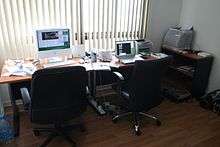Small office/home office


Small office/home office (or single office/home office; SOHO) refers to the category of business or cottage industry that involves from 1 to 10 workers.
History
Before the 19th century, and the spread of the industrial revolution around the globe, nearly all offices were small offices and/or home offices, with only a few exceptions. Most businesses were small, and the paperwork that accompanied them was limited. The industrial revolution aggregated workers in factories, to mass-produce goods. In most circumstances, the white collar counterpart—office work—was aggregated as well in large buildings, usually in cities or densely populated suburban areas.
Beginning in the mid-1980s, the advent of the personal computer and fax machine, plus breakthroughs in telecommunications, created opportunities for office workers to decentralize. Decentralization was also perceived as benefiting employers in terms of lower overheads and potentially greater productivity.
Professions
Many consultants and the members of such professions as lawyers, real estate agents, and surveyors in small and medium-size towns operate from home offices.
Several ranges of products, such as the armoire desk and all-in-one printer, are designed specifically for the SOHO market. A number of books and magazines have been published and marketed specifically at this type of office. These range from general advice texts to specific guidebooks on such challenges as setting up a small PBX for the office telephones.
Technology has also created a demand for larger businesses to employ individuals who work from home. Sometimes these people remain as independent businesspersons, and sometimes they become employees of a larger company.
The small office home office has undergone a transformation since its advent as the internet has enabled anyone working from a home office to compete globally. Technology has made this possible through email, the World-Wide Web, e-commerce, videoconferencing, remote desktop software, webinar systems, and telephone connections by VOIP. Due to the increase in small and home offices, web services and standard business software have been created to directly assist smaller businesses in standard business practice [1][2]
In the United States a home office can be claimed as a tax deduction only if office space and supplies are not provided by a corporate office.
See also
References
- ↑ DeBaise, Colleen. "Accounting 101: How to Keep Financial Records". Wall Street Journal. Retrieved 10 December 2013.
- ↑ Doyle, Carmel (12 July 2011). "Billfaster raises €330k to scale up online accounting globally". Ireland's Technology News Service. Retrieved 2 February 2014.
Further reading
- Basset, Brian (1997). Bless This Home Office ...With tax credits: An Adam Compilation. Kansas City: Andrews McMeel Publishing. [a comical view]
- Johnson, Karen K. (ed.), ed. (1998). Ortho's All About Home Offices. DesMoines, Iowa: Ortho Publishing Group. [mostly the home handyman's view]
- Manroe, Candace Ord (1997). The Home Office: Setting Up, Furnishing and Decorating Your Own Work Space. Michael Friedman Publishing Group Inc. [mostly a decorating view of things]
- Zimmerman, Neal (2002). Home Workspace Idea Book. Taunton Press. [small office and home office design of all types and sizes]
External links
| Wikiquote has quotations related to: Small office/home office |